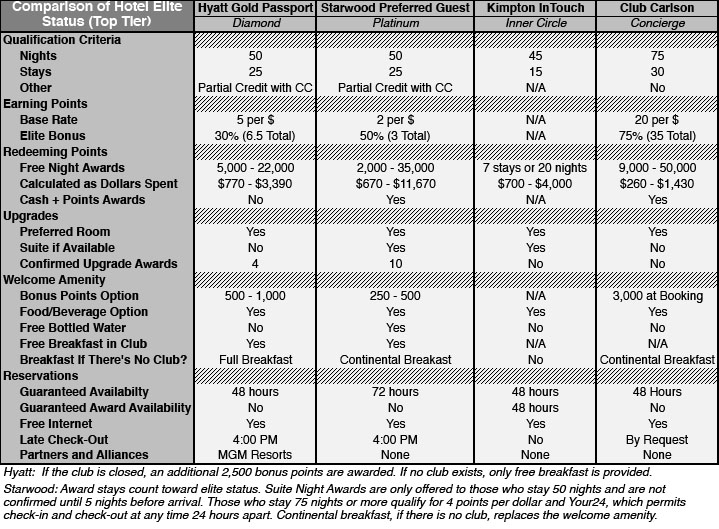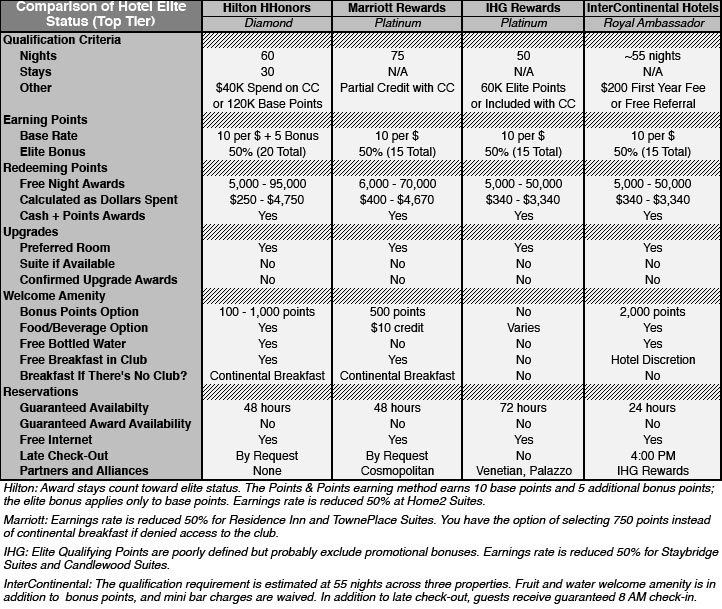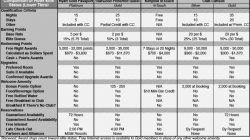My airline comparison tables were hugely popular, so I’ve created a similar table comparing hotel programs. Actually, I’ve been working on it for a while, off and on. There is a tremendous amount of variation in the kind of benefits they provide and the restrictions in their use. Making useful comparisons thus becomes difficult.
I decided to start at the top because hotel status is relatively easy to obtain, so I assume that this is going to be your goal. Many co-branded credit cards award status to lower tiers outright, and there is even greater variation in their benefits and qualification criteria. Update: tables for the lower tiers have since been published.
The programs I chose to compare are Hyatt Gold Passport, Starwood Preferred Guest, Kimpton InTouch, Hilton HHonors, Marriott Rewards, IHG Rewards (the new name for Priority Club), and InterContinental Ambassador (a specialized program within IHG Rewards). The first three are my preferred brands, so I put them together.
Finally, a word about how the tables are designed. Much like with the top tiers of airline loyalty programs, I ran out of space and decided to split the table into two. I did not include standard footnotes within the table because there were so many. Some of these programs have very nuanced rules, and it was easier to create an section at the bottom to explain all of these at once for each program. Be sure to read these caveats because the table by itself may be overly simplified. You can also download a PDF of all the program comparisons (including lower tiers).


Interpretation
I struggled sometimes with whether I should say “yes” or “no” for certain benefits. For example, InterContinental doesn’t guarantee a suite upgrade, and only suggests that it is one of several upgrade possibilities. In the past, some hotels have created special “Executive Rooms” not much different from standard rooms if only to avoid providing a suite upgrade. Starwood and Kimpton do promise an entry-level suite if available even though Starwood has issues with compliance. Hyatt does not promise a suite upgrade at all, but I have had rather good luck.
The fact is that any hotel can provide a suite at its discretion, so I used mine. Are you promised a suite, if available, to the exclusion of other non-suite room types? I think only Kimpton and Starwood meet this description.
Within the table, you may find also find entries that say “Varies” or “Discretion.” Both mean what they say. Benefits within some programs vary significantly depending on the brand and the property. IHG Rewards promises no real welcome amenity, but if one is available I’ve gotten everything from cookies and soda to nasal strips and a bottle of water.
“Discretion” has a more insidious meaning. InterContinental has discretion to assign you one of several upgrade room types. You receive club access only if you are assigned a club room. If you are assigned a different kind of upgrade, then the front desk has discretion whether to extend club benefits. Similarly, Marriott claims to offer late check-out, but you have to request on the day of departure, and the hotel can effectively give you whatever they want from a flat “no” to several hours. I have had Hyatt hotels gently encourage me to leave on time when they are full, but none have denied me a 4 PM check-out when I pushed back.
Analysis
I think we all knew that there were some big differences between loyalty programs. This table doesn’t do a whole lot to change general perceptions, but I think it does a good job of putting all the information in one place. You can tell now by looking at it just how bad Marriott Rewards is. It has the highest qualification requirement, the highest spend requirement to earn the lowest free night award, and some of the weakest benefits.
Take breakfast, for example. A Marriott hotel has the right to deny you club access. At that point, you’re offered free breakfast, but only a continental breakfast. And they might encourage you to take the 750 points instead. If Hyatt denied me club access, I’d get 2,500 points in addition to a full, hot breakfast.
This is one way that Hyatt stands out among its competitors (another is its flexible suite upgrades). Other programs stand out in their own ways. Starwood offers more suite upgrades, even if they are more restrictive, as well as better benefits if you are a “super” Platinum with 75 nights. (Don’t forget that Starwood is alone in offering elite stay credit for award nights, as well as credit for up to three rooms under the same reservation — great for families.) Kimpton suffers in many areas, including late check-out, but it has a very simple rewards program and is the only one to guarantee award availability. It also goes above and beyond in service and offers other ways to get free nights not listed here, including one free night at every new property.
Hilton is the only program that makes it possible to earn status just through credit card spend, though InterContinental makes it even easier with its referral program. One nice thing about InterContinental is that even though it has a limited number of hotels and unpublished qualification criteria, it treats its top-tier elites very well. One bad thing is that it has a less impressive reputation for recognizing status on award stays.
I will leave you with the most interesting conclusion (in my opinion): my calculation of the spending power required to earn a free night in each program. Don’t read too much into it because it is a range and ignores many good values in the middle. Hyatt, Starwood, and Kimpton all started out around $700 in spend to earn the cheapest free night (Kimpton’s range is based on a rate of $100-200 per night). You’ll notice that Starwood, however, is extremely expensive on the upper end. The effect is mitigated if you include the 5th free night on longer award stays, but it still suggests that those properties are either a horrible deal or must be pretty awesome. Maybe it just means that many Park Hyatt properties are an amazing deal at only 22,000 points!
Take a look at the other four programs, and you’ll see less variation. Here is where Marriott might win, with some of the cheapest top category awards, but Hyatt is not too far off. Hilton has some of the cheapest awards, though I’m not sure how many people are actually staying at Category 1 hotels. It is worth noting that even after Hilton’s recent devaluation, I still estimate it takes at most $4,750 in spend to redeem for a Category 10 hotel in the peak season. This is not far out of line from other programs and is well below the theoretical maximum for some Starwood properties.
Your Turn
Have I made any glaring errors or omissions? Please let me know! I went through a couple rounds of revisions on the airline tables before reaching a finished product. I admit I am not very familiar with some programs like Marriott. If benefits aren’t clearly explained online, I may not know they exist or how they are implemented in practice. Help me make this table better!

